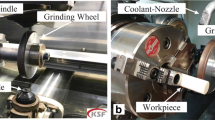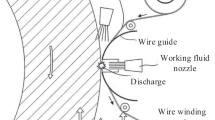Abstract
Diamond wheels are widely used in high-precision grinding of hard and brittle materials; unfortunately, they are difficult to true and dress. This paper addresses that problem in that it proposes an effective dressing technique—mist-jetting electrical discharge dressing (MEDD) of nonmetal bond diamond grinding wheels using conductive coating. A conductive phase is coated on the wheel surface to increase the conductivity of the nonmetal bond. Electrical discharge model was built to analyze feasibility and select optimized parameters of MEDD. Experiments were conducted to evaluate the dressing performance of MEDD in terms of surface morphology of the wheel surface, grinding force, and surface roughness of the workpiece. Experimental results show that abrasive grains on the wheel protrude are satisfied. The discharge parameters have an important influence on the dressing result. The grinding force and the surface roughness of the workpiece significantly reduced after dressing.
Similar content being viewed by others
References
Bhaskar P, Chattopadhyay AK, Chattopadhyay AB (2010) Development and performance evaluation of monolayer brazed cBN grinding wheel on bearing steel. Int J Adv Manuf Technol 48:935–944
Sanchez JA, Ortega N, Luis LN, Lopez de Lacalle LN, Lamikiz A, Marañon JA (2005) Analysis of the elecro-discharge dressing (EDD) process of large-grit size CBN grinding wheel. Int J Adv Manuf Technol 29:688–694
Kim JD, Lee ES (1996) A study of mirror-like grinding of fine ceramics with in-process electrolytic dressing. Int J Adv Manuf Technol 12:246–254
Kim JD, Lee ES, Choi JY (2005) A study on the development of in-process dressing lapping wheel and its evaluation of machining characteristics. Int J Adv Manuf Technol 26:211–218
Maksoud TMA, Mokbel AA, Morgan JE (1997) In-process detection of grinding wheel truing and dressing conditions using a flapper nozzle arrangement. Proc IME B J Eng Manufact 221(5):335–343
Xie J, Tamaki J (2008) Computer simulation of sub-micron-scale precision truing of a metal-bonded diamond grinding wheel. Int J Mach Tools Manuf 46:333–342
Yung KC, Chen GY, Li LJ (2003) The laser dressing of resin-bonded CBN wheels by a Q-switched Nd: YAG laser. Int J Adv Manuf Technol 22:541–546
Hosokawa A, Ueda T, Yunoki T (2006) Laser dressing of metal bonded diamond wheel. Ann CIRP 55:329–332
Wang XK, Ying BG, Liu WG (1996) EDM dressing of fine grain super abrasive grinding wheel. J Mater Process Technol 62:299–302
Sanchez JA, Pombo I, Cabanes I, Ortiz R, Lopez de Lacalle LN (2008) Electrical discharge truing of metal-bonded CBN wheels using single-point electrode. Int J Mach Tools Manuf 48:362–370
Cai LR, Jia Y, Hu DJ (2008) Dressing of metal-bonded superabrasive grinding wheels by means of mist-jetting electrical discharge technology. J Mater Process Technol 209:779–784
Brian KR, Albert JS, Ronald OS, Jeffery LA, Darryl JG, Marion BG (2002) Wire electrical discharge machining of metal bond diamond wheels for ceramic grinding. Int J Mach Tools Manuf 42:1355–1362
Weingärtner E, Sa J, Kuster F, Wegener K (2010) On-machine wire electrical discharge dressing (WEDD) of metal-bonded grinding wheels. Int J Adv Manuf Technol 49:1001–1007
Brian KR, Albert JS, Ronald OS, Ronald O, Samuel M (2002) Wear mechanism of metal bond diamond wheels trued by wire electrical discharge machining. Wear 252:644–653
Raffles MH, Stephenson DJ, Shore P, Jin T (2011) Electrolytic in-process dressing superfinishing of spherical bearings using metal-resin bond ultra-fine CBN wheels. Proc IME B J Eng Manufact 225:112–122
Ohmori H, Nakagawa T (1990) Mirror surface grinding of silicon wafers with electrolytic in-process. Ann CIRP 39(1):329–332
Indraneel B, Kumar AS, Rahman M (2010) Experimental study of wheel wear in electrolytic in-process dressing and grinding. Int J Adv Manuf Technol 50:931–940
Tanveer S, Indraneel B, Rahman M (2010) Efficient dressing of the wheel in ELID grinding by controllable voltage with force feed back. Int J Adv Manuf Technol 46:123–130
Wang Y, Zhou XJ, Hu DJ (2006) An experimental investigation of dry-electrical discharge assisted truing and dressing of metal bonded diamond wheel. Int J Mach Tools Manuf 46:334–343
Lee ES (2000) The effect of optimum in-process electrolytic dressing in the ultraprecision grinding of die steel by a superabrasive wheel. Int J Adv Manuf Technol 16:814–821
Eubank PT, Patel MR, Barrufet MA (1989) Theoretical models of the electrical discharge machining process I. A simple cathode erosion model. J Appl Phys 66(9):4095–4103
Patel MR, Barrufet MA, Eubank PT (1989) Theoretical models of the electrical discharge machining process. II. The anode erosion model. J Appl Phys 66(9):4104–4111
Kansal HK, Singh S, Kumar P (2008) Numerical simulation of powder mixed electric discharge machining (PMEDM) using finite element method. J Math Comp Model 47(11–12):1217–1237
Kadish A (1992) Parametric analysis of a surface electrical discharge model. J Appl Phys 71(12):5806–5819
Shabgard MR, Shotorbani RM (2009) Mathematical modeling of machining parameters in electrical discharge machining of FW4 welded steel. J World Acad Sci Eng Technol 52:404–409
Marafon J, Chousal JAG (2006) A finite element model of EDM based on the Joule effect. Int J Mach Tools Manuf 46(6):595–602
Joshi SN, Pande SS (2011) Intelligent process modeling and optimization of die-sinking electric discharge machining. Int J Appl Soft Comput 11(2):2743–2755
Das S, Klotz M, Klocke F (2003) EDM simulation: finite element-based calculation of deformation, microstructure and residual stresses. J Mater Process Technol 142(2):434–451
Vinod Y, Jian VK, Dixit PM (2004) Theoretical analysis of thermal stresses in electro-discharge diamond grinding. J Mach Sci Technol 8(1):119–140
Yeo SH, Kurnia W, Tan PC (2008) Critical assessment and numerical comparison of electro-thermal models in EDM. J Mach Sci Technol 203(1–3):241–251
Zhao WS (2003) Advanced electrical discharge machining technology. National Defence Industry Press, Beijing
Author information
Authors and Affiliations
Corresponding author
Rights and permissions
About this article
Cite this article
Xu, M., Li, D., Hu, D. et al. Mist-jetting electrical discharge dressing (MEDD) of nonmetal bond diamond grinding wheels using conductive coating. Int J Adv Manuf Technol 63, 955–961 (2012). https://doi.org/10.1007/s00170-012-3963-0
Received:
Accepted:
Published:
Issue Date:
DOI: https://doi.org/10.1007/s00170-012-3963-0




